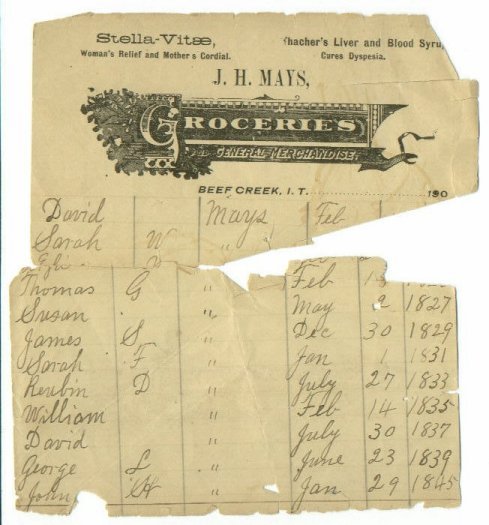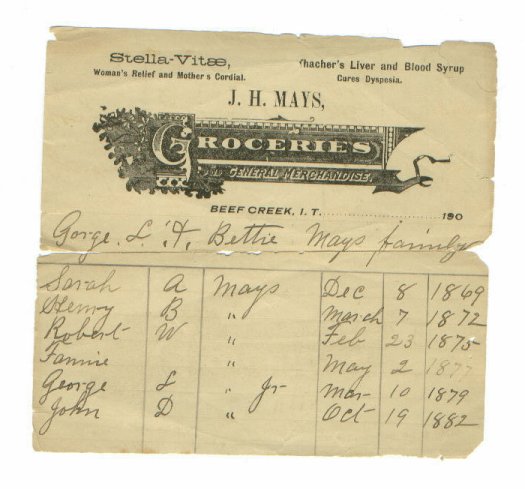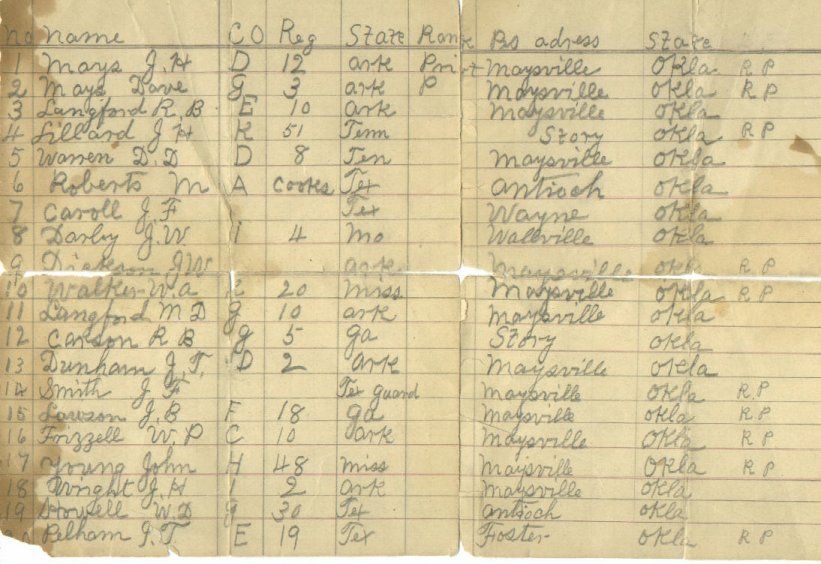
This material is donated by people who want to communicate with and help others. Every effort is made to give credit and protect all copyrights. Presentation here does not extend any permissions to the public. This material can not be included in any compilation, publication, collection, or other reproduction for profit without permission. |



I found these documents in the family archives and wanted to share them with others.
1st document is a list of the Mays family in its entirety. Sorry that the
first page was so crumbled that it did not survive. the name at the crease is Elas I
think.
2nd document is the list of Civil War Veterans and the units in which they served.
The third document is the family of George L and Bettie Mays. George was a
brother to David, John Henry, and William. There is an accounting of these
brothers in the Pioneer Papers of Ms. John H Mays (Ella Brumley). Also
Fanny Mays who was born in 1877 is Gene Autry's mother.
submitted by Joe Boatman
This material is donated by people who want to communicate with and help others. Every effort is made to give credit and protect all copyrights. Presentation here does not extend any permissions to the public. This material can not be included in any compilation, publication, collection, or other reproduction for profit without permission. |
Return to Pioneers Index
Return to Maysville Cemetery
DAVID MAYS
DAVID MAYS was born in Tennessee July 3, 1838, and fought for the
Confederates during the Civil War. He married a Mrs. Wilson, who was a
Chickasaw Indian, and they moved from Texas to Beef Creek in 1872 when
the area was a stockman's paradise except, of course, there were no
railheads close by.
Mr. Mays became one of the leading ranchers, and when the
railroad did come near to Beef Creek and the town moved to it, the new
town was named Maysville.
David Mays helped organize the first Methodist Church of Maysville,
giving use of land for the church and parsonage. His brother John was the
first postmaster of Maysville.
Mr. and Mrs. Dave Mays had two daughters, Laura and Ella, and three
sons, Will P., T.G., and Clarence.
Will Mays, with George Dykes and Bill
Guthrie, organized the First National Bank of Maysville.
From "Garvin County History"
submitted by Marlene Mays Clark
DAVID MAYS
David Mays was born in Tennessee July 31, 1837, but received his
education in Arkansas. When yet a youth he went to Texas, and there
remained until the breaking out of the Civil War, when he returned to
Arkansas and enlisted in the Third Arkansas Cavalry, serving with that
regiment until the close of hostilities. He again returned to Grayson
County, Texas, near Sherman, and there lived until after his marriage
to a widow, Mrs. S. E. Wilson. Two years afterward they removed to the
Indian Territory, where he began farming with a very small capital, but he now
owns about one thousand acres of valuable land, all under cultivation, and
about the same amount devoted to pasturage. He has always followed farming
and stock-raising, and in his pastures are seen very fine cattle, and he
also has several herds of mules and horses, while his fields are devoted to
the raising of the cereals best adapted to this soil and climate.
The marriage of David Mays and Mrs. S. E. Wilson was celebrated on
the 18th of August, 1868, at the residence of her mother, Mrs. Jane Bean,
near Sherman, Texas. Mrs. Mays bore the maiden name of Mitchell, and was
born July 24, 1840, near Memphis, Tennessee, a Chickasaw by blood. Her
father, Joseph G. Mitchell, was born February 24, 1809, in Mississippi, and was
a Chickasaw Indian, while her mother, who bore the maiden name of J. C.
Garrison, was born September 1, 1810.
Mrs. Mays had three children by her
first husband P.E. ---- Joe, John and Jennie, ---all born in Grayson County,
Texas. The union of Mr. and Mrs. Mays has been blessed with five children,
two daughters and three sons, the daughters having been born in Grayson
County, and the sons in the Chickasaw nation. Their names are Laura, Ella,
Willie, Thomas and Clarence, who still remain with their parents.
From "History of Indian Territory"
submitted by Marlene Mays Clark
DAVID MAYS
The family of which our subject was a member was originally from
Virginia. His father, whose name he bears and whose adventurous and
enterprising disposition he has inherited, was born in that State on the
16th of February, 1798, and was there married to Miss Sarah W. Daniels, a
Virginian by nativity, born June 13, 1810. Shortly after his marriage he
moved to Hickman County, Tennessee, and in 1849, to Arkansas, settling in
Dallas County, near Princeton. He raised a family of ten children, seven
boys and three girls, all but two of whom are still living. There were
named respectively: Eliza M., Thomas G., Susan, James S., Sarah F., R.D.,
William, J.L., J.H. and David. Thomas G. died just before the outbreak of
the late war, and Susan just after its close. The six remaining sons fought
through the war for the Southern cause and are still able to give battle for
the right. David Mays, Sr., died in 1870, the wife and mother in 1887.
Born in Hickman County, Tennessee, July 30, 1837, our subject, DAVID
MAYS, was in his twelfth year when the removal to Arkansas was made. His
father was a farmer, and the labor of the elder sons was needed in the
management of the little farm in the Dallas County hills. Here young MAYS
grew to manhood, amid the surroundings of a backwoods home, for at that
period Arkansas was far less populous than at the present time and the
counties in its interior could boast of comparatively few citizens. In
1859, he made a trip to Texas, and remained there two years, driving stage,
his route being from Spring Hill to Waco. When the war broke out, however,
he returned to Arkansas and enlisted in the 3d Arkansas Cavalry, serving in
this regiment for four years and four days, and being paroled after the
surrender at Greenville, South Carolina. After his military service was at
an end, he again visited Arkansas, and after remaining at home a short time
began looking about for some occupation, and as an experiment made his first
venture in the cattle business. This consisted of the purchase of 200 head
of beef cattle for which he paid twenty dollars a head in gold, and which,
after driving them to the Arkansas River, at Pine Bluff, he shipped by
steamboat to Memphis. The freight on the cattle amounted to four dollars a
head, and after holding them at Memphis for ten days, MR. MAYS was taken
down with a fever and had to engage the services of a man, named John
Hunter, to dispose of them for him. The sale was finally effected, but the
price received was only twenty dollars a head, and that too in greenbacks.
It had proven an unprofitable deal all around, and after remaining at home
until he had fully recovered from his illness, our subject started out to
make good his losses.
Turning again to Texas, he landed in Grayson County in due course of
time, and hired to John Owens at fifteen dollars a month, to haul freight
between Jefferson and Sherman with a six-mule team. After the first month
he was "promoted" to the position of "boss" over three teams and his
salary
was raised to twenty-five dollars, at which figure it was continued for a
year. In the meantime events were occurring which were fated to have a
lasting effect on his entire life. Meeting a young widow named Mrs. Susan
Wilson, he found his heart slip from his keeping at the first glance of her
laughing brown eyes, and pressing his suit with his characteristic vigor he
eventually won her consent and they were married on the 18th day of August,
1868, at the residence of the bride's mother, Mrs. Jane Bean, near Sherman.
Mrs. Mays maiden name was Mitchell, and she was born near Memphis, July 24,
1809; her mother, before her marriage, was Miss Jane C. Garrison, born
September 1, 1810. Mrs. Mays had three children by her first husband, Mr.
Wilson, namely: Joseph B., John D. and Jennie L., all of whom were born in
Grayson County. She has a slight touch of Chickasaw blood, and as such has
rights as a citizen of that nation.
After their marriage MR. and MRS. MAYS moved on a farm, seven miles
northeast of Pilot Point, in Grayson County, where they lived one year, and
then moved on a place six miles southwest of Sherman. In January, 1872,
after two years' residence at the place last mentioned, they moved into the
Indian Territory, locating at what is now known as Beef Creek in the
Chickasaw Nation. The country was then almost entirely undeveloped and few
wilder or more beautiful spots were ever seen than that whereon MR. MAYS
erected his first home in the Territory, a cabin built of cottonwood and
pecan logs. Little space was required, for the house was only 12 x 14 feet
in area, while the roof was made of rude clapboards and the floor of the
natural earth, merely leveled and a few of the largest stumps and bushes
removed. In MR. MAYS' words, the family then numbered fourteen persons,
including hired help, and ten fox-hounds. Mrs. Mays was the only lady in
the vicinity, and there was only one neighbor in a radius of ten miles. The
fertile valley of the Washita lay spread out around them, as yet innocent of
the touch of a plow. MR. MAYS was the owner of fifteen yoke of work cattle,
and as soon as his building operations were at an end, he began turning over
the virgin soil, preparatory to opening a farm. He worked five yoke of
cattle to each plow, running three plows from Monday morning until Friday
night, while on Saturday all the hands would turn to and plant the broken
ground in corn. The mode of procedure was simple, for they would only make
a hole for the seed corn with a sharpened stick, covering it with a little
dirt pressed upon it with the foot. In that way 2250 acres were planted
that spring, which, without any cultivation whatever, averaged thirty-five
bushes to the acre in gathering time. After the crop was made MR. MAYS sold
his work cattle to feeders at $37.50 a head, and then borrowed a four-horse
and a two-horse team and hauled lumber from Denison, Texas, a distance of
125 miles, building a "box house" which, by the way, had glass windows,
though hewed logs and rough poles were used for sills and rafters.
When MR. MAYS moved to the Indian Territory, he carried with him
eight head of stock cattle, fifteen head of horses and one span of small
Spanish mules. In the winter of 1873 he made a trip to Texas, where,
finding cattle very cheap, he purchased 100 head of yearling steers and
heifers for which he paid $1.75 a head. He also bought from John Jenks, of
Grayson County, sixty head of stock cattle, for which he paid six dollars a
head. He put these cattle on full feed, and when they were three and four
years old, sold them for forty dollars a head. The following spring he
bought 200 head of two and three-year-olds from George Drennan and "Cheek"
Towery at eighteen dollars a head, which were also sold for forty dollars in
due time. His next transaction was the purchase of 280 head of
four-year-olds from Dick Nail at seventeen dollars a head, which he fattened
and shipped to Kansas City, selling them for thirty dollars. His subsequent
deals have been on a more extensive scale, and he has thus far been very
successful. He has now between 1,500 and 2,000 head of cattle, of which
about 1,000 or 1,200 will be ready for the spring market.
In 1887 MR. MAYS decided that he could quickly accumulate a fortune
raising horses, and he made a trip to Texas, and purchased 450 head from the
Merchants and Planters National and City Banks of Sherman, for which he paid
twenty-five dollars a head, and also bought eighty-three head from Lige
Emberson, of Pilot Point, at the same price. After considerable experience
in this branch of stock growing he has changed his opinion of the profit to
be derived from it and has been shipping his horses to Arkansas and other
States and exchanging them for cattle, until he has now only some 200 left.
His farm which, at the time of the original purchase, in 1872, comprised 250
acres, has since been added to until he has now about 2,000 acres of as
fine land as can be found in a half-dozen states, and the 12 x 14 log mansion
has given place to a nice two-story frame structure which is flanked by a
good barn and other outbuildings. His cattle range which, in 1872, was
limited by the boundaries of the Chickasaw and Choctaw nations is now cut
down to 10,000 or 12,000 acres, which is surrounded by a good three wire
fence. MR. MAYS is now fifty-seven years of age, but is still active in
business matters, and finding that ranching and farming was becoming too
slow for his juvenile tastes, he has, within the last two years, bought a
home and a livery stable in the wide awake hustling little city of Purcell,
where he could find a better field for enterprise, and where he is glad to
meet his friends on any and all occasions.
Five children have been born to MR. and MRS. MAYS, three sons and
two daughters. Laura G., married W.T. Shannon of Dennison, Texas; Ella is
the wife of Scott Jones, of Sherman, Texas. Both girls were born in Grayson
County and educated at the North Texas Female College of Sherman. The sons
were born in the Chickasaw nation. William P. and Thomas G. are now
attending school at Dallas, Texas and will shortly graduate, while Clarence,
the youngest, though only fourteen years of age is boss over his father's
ranch.
From "Historical and Biographical Record of the Cattle Industry and the Cattlemen of Texas and Adjacent Territory"
submitted by Marlene Mays Clark, great grand daughter

Red Mays


This document was last modified on: